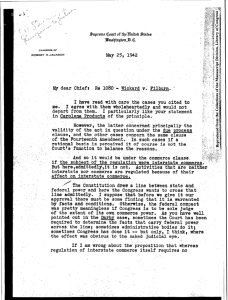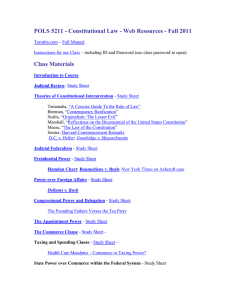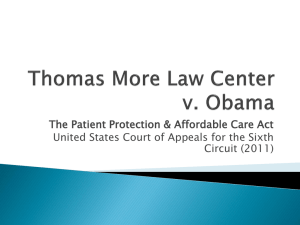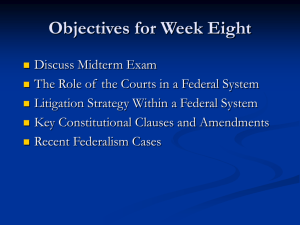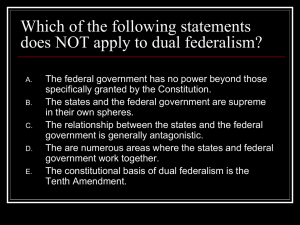8Federalism and Constitutional Law
advertisement
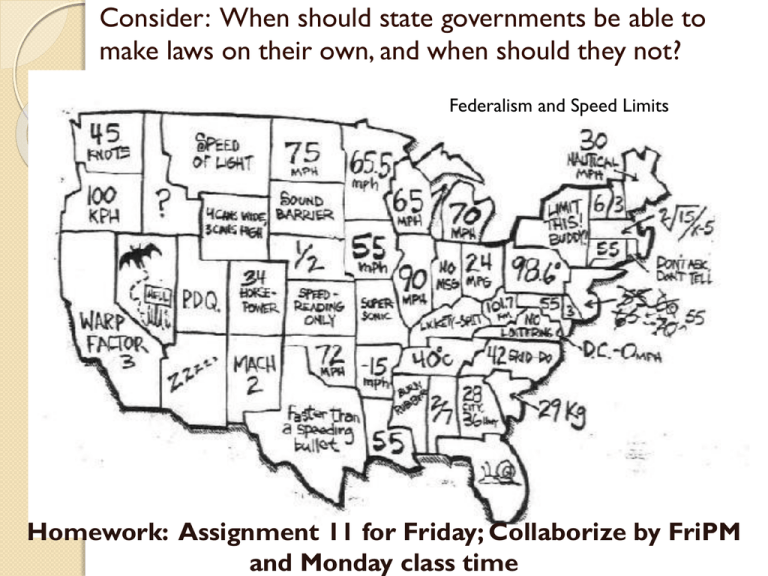
Consider: When should state governments be able to make laws on their own, and when should they not? Federalism and Speed Limits Homework: Assignment 11 for Friday; Collaborize by FriPM and Monday class time Federalism The Tug-of-War Between States and the National Government IT’S ALIVE!!!! Video: The Big Picture 3 http://media.pearsoncmg.com/ph/hss/SSA_SHARED_MED IA_1/polisci/presidency/OConner_Ch03_Federalism_Seg1_ v2.html Federalism The Tug-of-War Between States and the National Government Federalism The Tug-of-War Between States and the National Government Federalism The Tug-of-War Between States and the National Government Federalism How/where is federalism established in the Constitution? ◦ Why do you think this was something the Framers developed? How is federalism different from the concept of the “separation of powers?” How is this different from the principle of checks and balances? FIGURE 3.1: Where does governmental authority come from? 3.1 British Colonial Rule Unitary System – all power flows from one central government Powerful British Government Political Subunits (Colonies) – some selfgovernment, but not much Articles of Confederation 1781 – 1789 – RIP Confederate System – power concentrated in political subunits (states) with a weak central government (typically unite for a common goal) The US Constitution Federal System – powers are divided and/or shared between state and central governments (Current gov’t designed by framers) - Key component: states/subdivisions have the final word on some decisions Central US government We The Peeps State governments FIGURE 3.3: How many governments exist in the United States? 3.1 When do national and state governments work together? 3.1 Analyzing our Federal System What advantages does the federal system provide our nation? What problems exist because of our federal system? What is the difference between the states’ rights position and the nationalist position with regard to government power? The ACA Case (2011) Amid intense public interest, Congress passed the Patient Protection and Affordable Care Act (ACA), which became effective March 23, 2010. The ACA sought to address the fact that millions of Americans had no health insurance, yet actively participated in the health care market, consuming health care services for which they did not pay. The ACA contained a minimum coverage provision by amending the tax code and providing an individual mandate, stipulating that by 2014, non-exempt individuals who failed to purchase and maintain a minimum level of health insurance must pay a tax penalty. The ACA also contained an expansion of Medicaid, which states had to accept in order to receive Federal funds for Medicaid, and an employer mandate to obtain health coverage for employees. Question(s) Presented: ◦ 2) Does Congress have power under Article I, Section 8 of the Constitution, specifically under the Commerce Clause or the Taxing and Spending Clause, to require most Americans to purchase health insurance? ◦ 4) Did Congress exceed its enumerated powers and violate principles of federalism when it pressured States into accepting conditions that Congress could not impose directly by threatening to withhold all federal funding under Medicaid, the single largest grant-in-aid program? Consider: How has federalism seemed to follow a “back and forth” course over American history? Homework: Assignment 12 for Tuesday; Collaborize by Mon. Madison’s Arguments in Federalist 39 The topic: Whether the nature of the republic created by the Constitution is of a “wholly (con)federal or wholly national character.” ◦ This was intended to answer critics who said the Constitution consolidated the states into a unitary government, and took away the sovereignty of the states entirely. Madison claims that the nature of the government is indeed not wholly federal, or wholly national, but rather a composition of both. He cites the following four areas to make his argument. ◦ ◦ ◦ ◦ Foundation: States will ratify the Constitution (F) Sources of power: House and Senate, President (F/N) Extent: states have some control (F/N) Amendments: process includes states and national gov. (F/N) Federalism and the Marshall Court Defining National Power: McCulloch v. Maryland (1819) Affirming National Power: Gibbons v. Ogden (1824) Limiting the Bill of Rights: Barron v. Baltimore (1833) 3.2 Defining National Power: McCulloch v. Maryland (1819) 3.2 First Court decision to define national and state government relationship Could Congress charter a bank? Could states tax it? Ruling: Congress’ power to charter a bank falls under its power to tax, etc. States cannot tax because the nat’l gov needs to remain supreme Affirming National Power: Gibbons v. Ogden (1824) Congress’s authority under commerce clause disputed Power to regulate just products or commercial activity too? Ruling: Congress can regulate commercial activity New York had no authority to grant monopoly 3.2 Limiting the Bill of Rights: Barron v. Baltimore (1833) Due process clause Guaranteed by Fifth Amendment Action by state, not federal, government caused damages Federal government not at fault for state actions 3.2 States Assert Their Powers: Nullification Nullification States declare federal laws invalid Alien and Sedition Acts (1798) Unconstitutional “Tariff of Abominations” (1828) Southern states use nullification to resist anti-slavery laws 3.3 States’ Rights and the Dred Scott Decision Dred Scott v. Sandford (1857) Slaves were property, not citizens Congress could not ban slavery in new territories Enhanced states’ power 3.3 The Rehnquist Court Appointed by Reagan Committed to states’ rights Rolled back federal authority U.S. v. Lopez (1995) 3.6 United States v. Lopez Facts The Gun-Free School Zones Act of 1990 (GFSZA) made it unlawful for any individual knowingly to possess a firearm at a place that he knew or had reasonable cause to believe was a school zone. Alfonso Lopez, Jr., a 12th-grade student, carried a concealed and loaded handgun into his high school and was arrested and charged under Texas law with firearm possession on school premises. The next day, the state charges were dismissed after federal agents charged Lopez with violating the Act. Issues Does the GFSZA exceed Congress’ authority under the Commerce Clause? What categories of activity may Congress regulate under its commerce power? Holding and Rule (Rehnquist) Yes. The GFSZA exceeded Congress’ authority under the Commerce Clause. The three broad categories of activity that Congress may regulate under its commerce power are: ◦ a) the use of the channels of interstate commerce; ◦ b) the instrumentalities of interstate commerce, or persons or things in interstate commerce, even though the threat may come only from intrastate activities; and ◦ c) those activities having a “substantial relation” to interstate commerce, i.e., those activities that substantially affect interstate commerce. The Supreme Court held that the GFSZA exceeded Congress’ Commerce Clause authority. The possession of a gun in a local school zone is in no sense an economic activity that might, through repetition elsewhere, have a substantial effect on interstate commerce. Neither the Act itself nor its legislative history expresses congressional findings regarding the effects of gun possession in a school zone on interstate commerce. To uphold the Government’s contention that the Act is justified because firearms possession in a local school zone does indeed substantially affect interstate commerce would require this Court to pile inference upon inference in a manner that would convert congressional Commerce Clause authority to a general police power of the sort held only by the States. Dissents in US vs. Lopez Dissent (Stevens) Guns are articles of commerce and can be used to interfere with commerce. The national interest justifies prohibiting their use by children in school. Dissent (Souter) The only inquiry should be whether the legislative judgment is within the realm of reason. Congress should have plenary power to legislate under the Commerce Clause as long as the law passes the rational basis test. Dissent (Breyer) Violence in schools interferes with the quality of education and education is inextricably tied to the economy. Congress could have rationally concluded that the possession of guns in school zones is related to interstate commerce. The majority contradicts well settled precedent that has permitted Congress to regulate noncommercial activity affecting interstate commerce. The Roberts Court Has decided in favor of the federal government more often Immigration Health care reform – Obamacare decision 3.6 The ACA case(s) Does Congress have power under Article I, Section 8 of the Constitution, specifically under the Commerce Clause or the Taxing and Spending Clause, to require most Americans to purchase health insurance? Is the individual mandate severable from the ACA? Did Congress exceed its enumerated powers and violate principles of federalism when it pressured States into accepting conditions that Congress could not impose directly by threatening to withhold all federal funding under Medicaid, the single largest grant-in-aid program?
